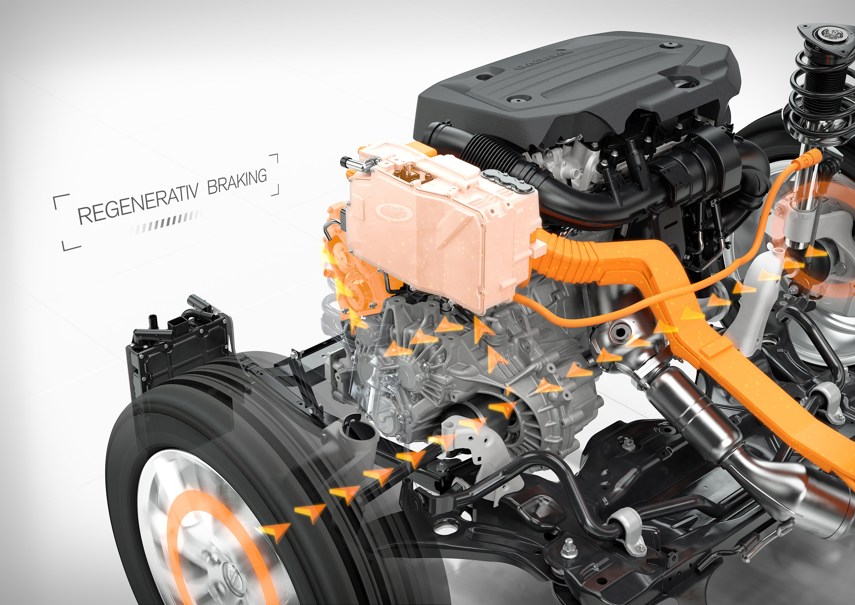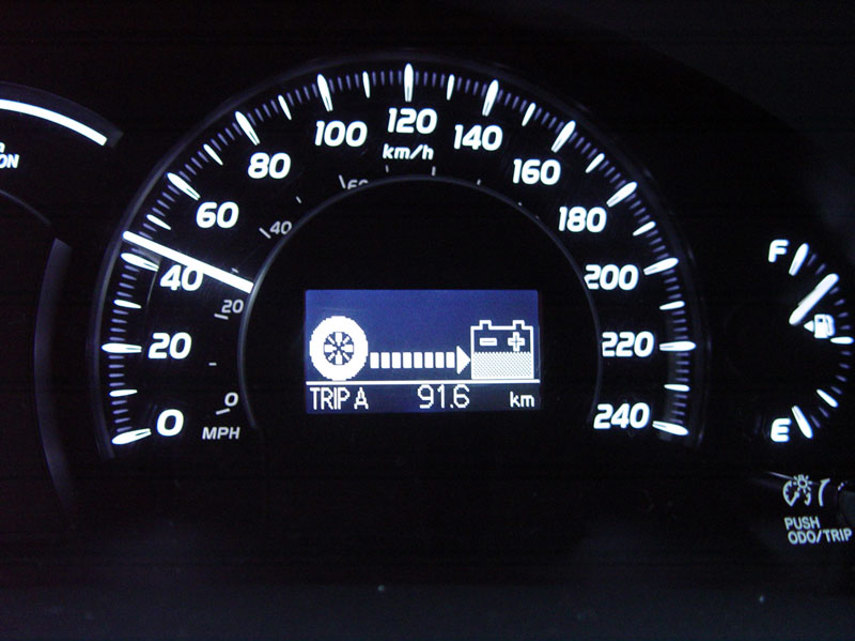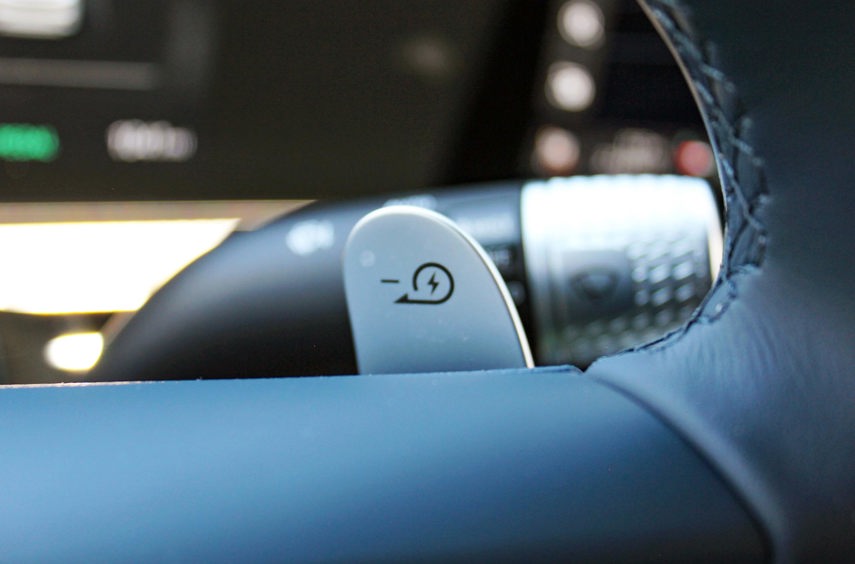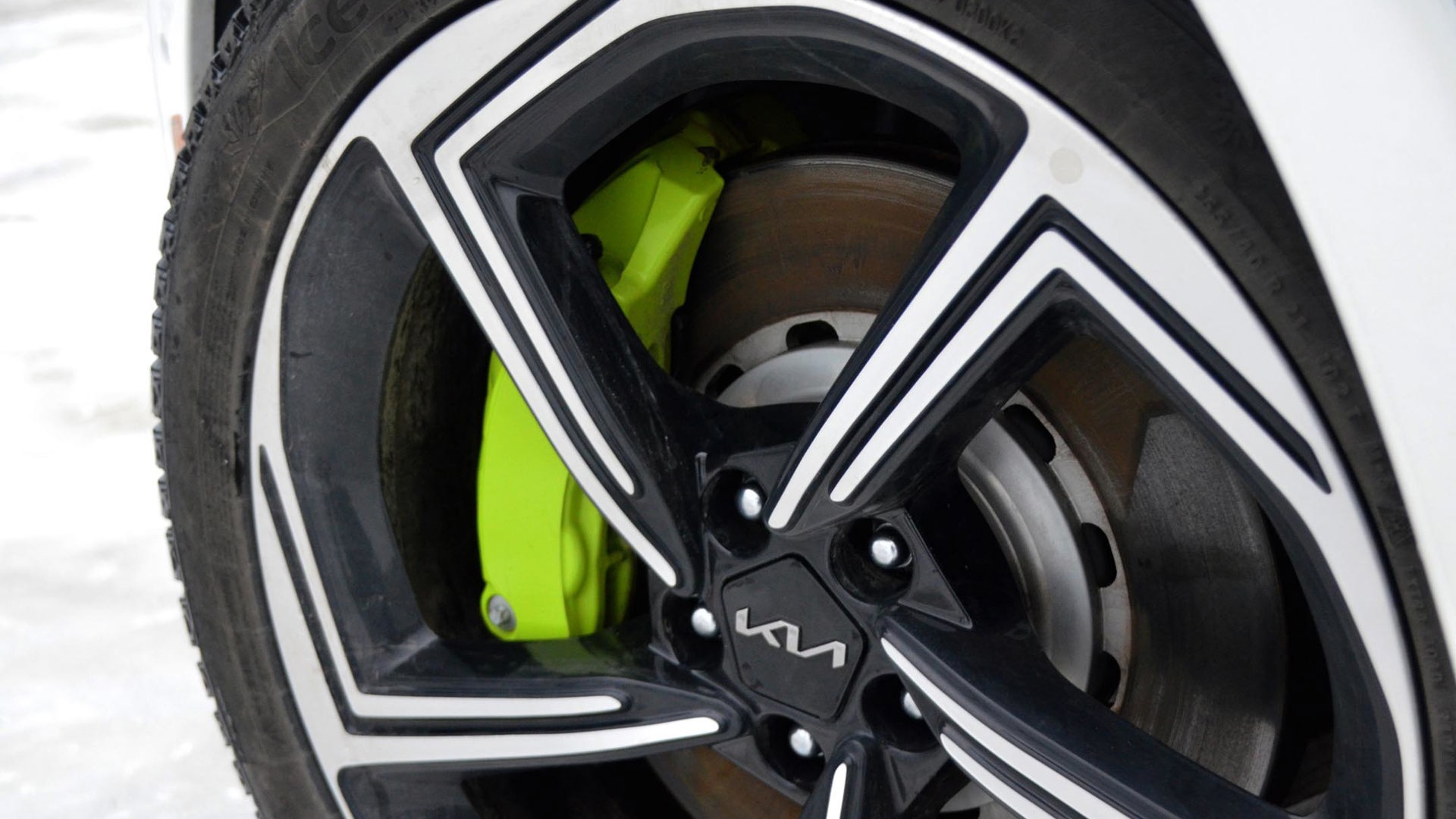If you’re one of the growing number of Canadians shopping for an electrified vehicle like a hybrid, plug-in hybrid, or all-electric, you’ll be encountering the term “regenerative braking” while reading spec sheets, watching reviews, and reading up on model literature during your research.
Regenerative braking can sound pretty complicated, but it’s actually a straightforward concept. In this article, we’ll define regenerative braking, demystify how it works, and answer some of the most popular web search questions about it.
Mechanical vs. Regenerative Braking
Let’s kick this voyage off with a recap of how conventional braking systems work: pressing the brake pedal builds hydraulic pressure, which causes your brake calipers to squeeze your brake pads against the rapidly spinning brake rotors, generating a tremendous amount of friction, which slows down your car.
Friction converts kinetic energy into a tremendous amount of heat energy. Ever see a race car with its brakes glowing red hot? The more you brake, the more friction occurs, and the hotter the brakes get. There’s a lot of heat energy generated when stopping a car using conventional brakes, and all of that energy is wasted as it dissipates into the environment.
What if a car could recapture some of that wasted energy, turning it into electricity instead of heat? That’s just what hybrid and electric cars do by taking advantage of their electric motors.
The addition of electric motors to a vehicle unlocks another ability: regenerative braking. In a hybrid or electric car, the motor(s) can be used to do some of the work of slowing down the vehicle while simultaneously recharging its battery. In this way, electric motors are used to help recover a portion of the energy that would otherwise be lost as heat while braking.
Here’s how that works.
When slowing down or braking, the wheels of your vehicle aren’t being driven, but they’re still spinning – meaning they can drive the electric motor(s), turning them into generators that create electricity to store in the battery.
When you’re pressing the throttle, the electric motor applies power to the wheels. When you release the throttle or release the throttle and press the brakes, the spinning action of the wheels drive the motors as generators instead.
How does regenerative braking slow the vehicle down?

On the all-electric Porsche Taycan, Ingo Albers, Porsche’s Head of Chassis Development in Weissach, says, “We incorporate the electric motors we produce in Zuffenhausen into the brake system for the purpose of energy recovery.”
According to Albers, electric motors can generally be controlled in four-quadrant operation. The motor can work with both the rotation speed and torque running in the same (positive) direction. But each electric motor can also function as a generator, in which case the motor continues to turn in the same direction, but is now powered by the wheels rather than powering them itself.
“This generates electrical energy, rather than consuming it,” explains Albers. “And because it takes a lot of energy to power the motor and thus turn the rotor against the magnetic resistance, this negative torque can be used to brake the vehicle.”
No matter what type of electrified vehicle you’re driving, the principle is the same: the electric motor can drive your wheels one moment and be driven by your wheels the next, generating electricity in the process.
By the way, according to Porsche, kinetic braking energy force is higher the faster you drive. When braking from 100 km/h, for example, the Taycan generates four times as much energy as when braking from 50 km/h.
How much does regenerative braking help?
Regenerative braking does a lot to help maximize efficiency.
Christopher Bolletta, Nissan Canada’s senior manager of Product Planning and Vehicle Connected Services says, “Regenerative braking is being used approximately 90 per cent of the time during day-to-day driving.”
Julian Cheng, Product Planner at Hyundai Canada, adds, “In a real-world city cycle, regenerative braking could improve range by up to 40 per cent. This is a rough estimate, not the regulated cycle testing we use to issue official range values.”
“Regenerative braking is a key part of maximizing range, and there can be a great benefit when used properly in optimal conditions,” explains Kia Canada’s National Manager of Training, Reg Furoy. “All systems are computer-controlled and monitor driver inputs, regeneration mode, battery state of charge/health – and will react accordingly to maximize power and battery charge functions.”
How quickly can an electric motor switch between “motor” and “generator”?
“Switching is almost instantaneous, up to a few hundred milliseconds to microseconds, depending on individual motor speed,” Hyundai’s Cheng explains.
“Theoretically, it can instantly switch just by reversing energy flow among the battery, inverter, and motor,” adds Nissan’s Bolletta.
What happens in an emergency stop?

While regenerative braking can cover most of your day-to-day braking needs, there are still situations where the electric or hybrid car’s conventional brakes need to snap into action.
According to Hyundai’s Cheng, “Conventional braking is the majority at a very low speed, or when more brake torque is required than is available from the motor. Emergency stops (vehicle in front slams brakes), low traction conditions (winter conditions), and while the vehicle is at a stop in i-pedal/auto-hold, all these situations will use conventional (mechanical) braking.”
“Brakes are an integral part of traction control, especially on slippery surfaces, ABS is needed for safety,” adds Kia’s Furoy. “Regenerative braking slows down the vehicle as it recharges, however, it cannot stop the vehicle in an emergency or hold the vehicle when on a hill or at a stop sign.”
How does regenerative braking work on snow and ice?
While regenerative braking can be put to use in a wide variety of situations, help from the vehicle’s conventional braking system is important when the roads get slippery. When traction runs low, regenerative braking forces may exceed the traction available at the wheels, requiring intervention from the conventional mechanical brakes and specifically the anti-lock (ABS) function.
“In terms of road surface, regenerative braking is working until the point you lose grip and then friction brakes are used for compensation/stabilization when needed,” explains the Polestar engineering team. “For very slippery conditions, this can also mean anti-lock braking activation. Blending of these elements are fully automatic and create the best possible braking solution for the driver.”
Can bigger motors (or more motors) recover more energy?
“In theory, a larger motor may recover more energy,” explains Hyundai’s Cheng. “However, there are many considerations for energy capture. If the motor power is larger than the allowable battery input power, we can only capture as much energy as the battery is able to accept (maximum power). Also, larger motors are heavier, so there can be energy wasted on spinning the motor and hauling the extra weight around.”
Bolletta says that Nissan limits braking force to lower than 0.2G because any more than that would hamper a car’s drivability. “Larger EV motors can capture more energy than smaller ones, but it’s not quite that cut and dry,” he says. “It makes the transition to conventional brakes more difficult and harms drivability.”
Is regenerative braking bad for the battery?

It’s unclear why this is such a popular search question, or where people get the idea that regenerative braking is harmful for the battery, because it’s not at all harmful.
“Regenerative braking has a similar impact on the battery as regular charging,” explains Bolletta. “Any degradation is normally caused by the heat of a charge or discharge cycle. In this case, regenerative braking does not generate as much heat because the output is smaller and charging time is shorter than quick charging.”
Can regenerative braking be turned off?
No, but most cars allow the driver to control its effect on the way the vehicle drives.
For instance, in models like the Hyundai Ioniq 6, Nissan Ariya, and Kia EV6 or Soul EV, the level of regenerative braking can be adjusted by the driver on the fly. This alters the way the vehicle responds when the accelerator is released.
In many EVs and PHEVs, drivers can use paddles behind the steering wheel or settings accessed through the touchscreen to toggle between various levels of regeneration. In the lowest of these settings, the vehicle will coast when the accelerator is released. As the regen levels increase, the vehicle slows more aggressively when the accelerator is released. In the most aggressive setting, even lightly releasing pressure from the accelerator has an effect similar to a good stomp on the brake pedal.
Do regenerative brakes help the friction brakes last longer?
Yes, using the regenerative brakes will prolong the life of your friction brakes because you’ll be using them less, but this comes with a warning.
The brake pads and rotors in an EV or hybrid have less work to do since the electric motor(s) handle most of the workload during everyday braking. Brake parts wear out a little every time you use them to slow down, but electric motors don’t, so you’re likely to see a significant improvement in the life of brake system parts in a hybrid or EV.
Still, some owners of models like these have reported a tendency for brake parts, especially those on the rear of the vehicle, to suffer premature rust, damage, and corrosion attributed to their lack of frequent use. Be mindful that the brakes in your hybrid or EV may be more sensitive than regular brakes to the negative effects of corrosion formation during extended storage. Even if you’re using regen braking most of the time, make sure you’re working those conventional brakes at least a few times per trip to keep them from corroding faster than necessary.
Why is my regenerative braking not working?

When your EV or hybrid’s battery is totally full, regenerative braking isn’t possible, since there’s no room left to store more energy in the battery. So, if you don’t feel regenerative braking in action, it might be because your battery is already fully charged.
You may have also accidentally switched the function off or turned it down in the vehicle settings menu, and some cars default to a low regenerative braking setting every time you start them up.
Certain temperature or operational constraints relating to the battery may temporarily prevent regenerative braking from kicking in too, though these situations are rarer and typically brief.

